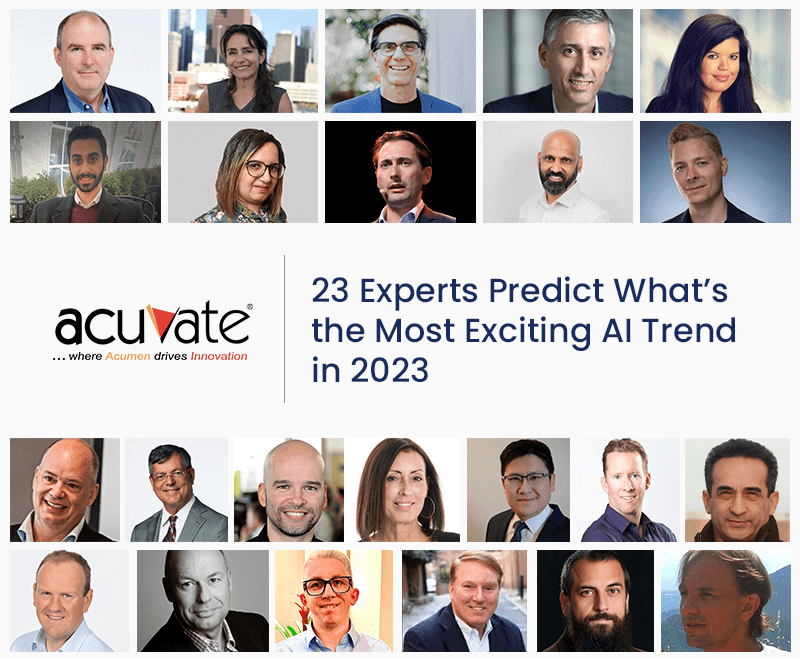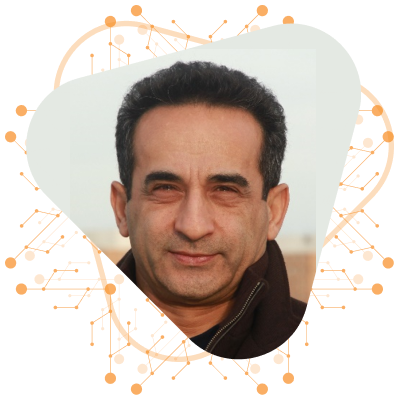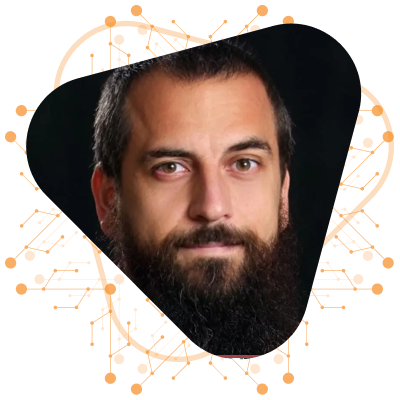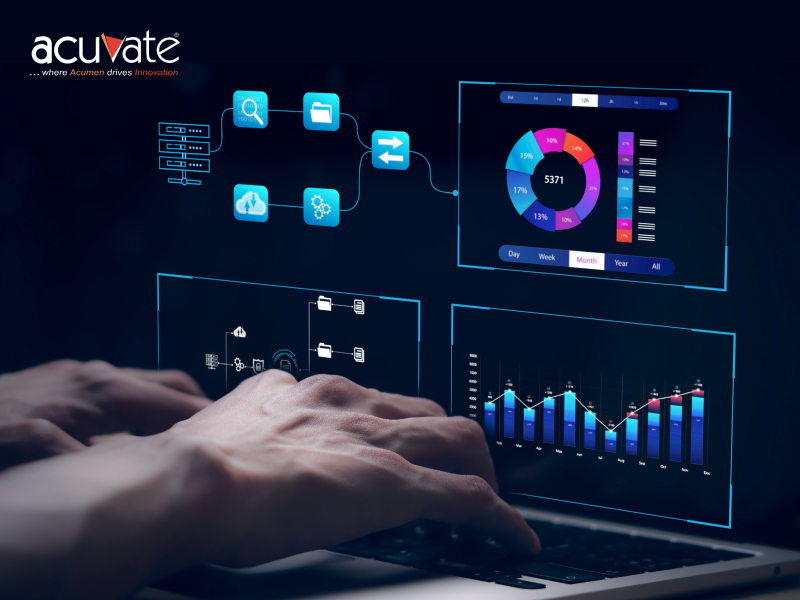The future of Artificial Intelligence is a hotly debated topic, with countless predictions and speculations about its potential impact. With the rise of Generative AI and Adaptive AI, the field is rapidly evolving and advancing. At Acuvate, we have been using AI to revolutionize business processes. To gain a deeper understanding of what’s to come, we asked 23 of the top AI specialists globally this question: ‘What is your prediction for the materialization of AI in 2023?
Here's what the experts believe about the future of AI.
Be prepared for the Generative AI battle
ChatGPT frenzy release did not go unnoticed! You can hardly ignore the fact that it has crossed one million users within a week of its launch and sparked a $10 billion investment discussion with Microsoft. 2023 is going to be an exciting time, now that OpenAI made its move there is no doubt that the tech giants will enter a battle of the titans.
The battle will not only focus on conversational AI but will spill into other areas such as search engines with Microsoft plans to combine ChatGPT with Bing. With commercialisation in mind, we will see business applications extending to sectors such as marketing, advertising, legal and customer services.
However, despite the latest successes, Generative AI models lack crucial capabilities such as understanding and reasoning. Addressing AI ethics and bias needs to remain a top priority.
The risks and benefits of generative AI will become better and more realistically understood
Generative AI exploded at the end of 2022. There is a mix of hype on both the positive and negative sides. Some people say that generative AI will revolutionize the world and some say it will destroy it. As always, there will be good and bad, but likely not the extreme cases so often discussed thus far. In 2023, there will be time for a more sober and thoughtful examination of the upside and pitfalls of generative AI and we’ll figure out how to move forward with it effectively.
Creative Generalists become armies of one…
Millions have experienced the incredible capabilities of tools like ChatGPT and Dall-E but we haven’t seen anything yet. Similar tools are being developed for video, audio, 3D, and other technical fields. Creative Generalists – professionals who have deep expertise in one area and general knowledge in several others will become indispensable as they’re able to create assets drawn from dozens of technical skills that would normally take teams of specialists to produce. This is the age of the technical solopreneur.
The most exciting AI trend for science and engineering is modeling physical phenomena using AI instead of traditional science and engineering approaches. The AI-based modeling of physics is purely based on actual measurements instead of mathematical equations and therefore it avoids assumptions, interpretations, and simplifications. My 30 years of research, development, and consulting for petroleum industry has resulted in technologies that model the physics of hydrocarbon reservoirs completely different from traditional reservoir simulation and modeling. This new technology called AI-base (Top-Down) Reservoir Simulation and Modeling (TDM) performs comprehensive history matching and creates forecasting, infill location, and production optimization far better than traditional physics-based modeling.
Next wave AI The consumer lead revolution. Introduction
Artificial Intelligence (AI) has the potential to change our lives for the better. We are moving from a period of industrialization to the era of data-driven services and automation, with AI being at the heart of this transformation. As our lives become increasingly digitized and connected, we need new ways of organizing and organizing information for large organizations as well as individuals. The consumer-led revolution is about integrating artificial intelligence into everyday life in ways that will help us make more informed decisions about our health, finances, and lifestyles – it’s a powerful way to harness exponential technology! Like the PC it is the consumer that will be dragging the enterprise into the AI age.
Mass adoption of AI tools
You’re likely already using AI tools in your daily life. Think about how many people have used Siri to schedule a doctor’s appointment, or how many others have used Google Maps to get directions while driving. AI is infiltrating all aspects of our lives, and it has the potential to make our lives easier: not just at work but also at home.
A recent study by Oracle revealed that 82% of consumers would prefer an AI-powered assistant over a human being when performing tasks like scheduling meetings, buying tickets online and traveling abroad. In fact, the same study found that 60% of respondents were willing to pay for such services—and that number only increases if those services were free! Now we are seeing the same consumers comfortable using business AI tools for Content, Presentations, decision-making. Consumers are bringing these tools into the workplace the same way they did with Laptops, Phones, and Tablets.
Consumer-led AI disruption in the enterprise
The next wave of disruption is here and it’s going to change the way we work, interact with each other and do business. This new paradigm is powered by AI.
The first wave of the internet was built on the back of consumer-led innovation. The second wave brought us social networking, which led to mobile computing that completely changed how we access information in our daily lives; this was followed by cloud computing, which transformed how data can be accessed and managed from anywhere at any time.
Now we’re entering a third wave powered by AI that will enable consumers across industries—from retailing to healthcare—to interact with their devices in new ways and get more out of their data assets than ever before.
AI is now mainstream and integrated in both our work and our lives. AI will keep on improving in the field of Perception, Representation & Reasoning, Learning, Human-AI Interaction, and Societal Impact. One technology which has reached maturity and is expected to have a significant impact in 2023 is Computer Vision. While Tesla may finally get its car fully autonomous the safety or our citizens in schools and public places will improve with automated recognition of unsafe situations.
The most interesting AI trend to be materializing in the industrial enterprise context will be what we here at Beyond Limits call Knowledge Base Operations (KBS) as applied to engineering applications. KBS will place the optimization of an industrial complex at the fingertips of its unit operators, guiding them and enhancing the Advanced Process Controls.
Consumer-led AI disruption in the enterprise
Do you recognize the statements below about the future?
In 10 years…
– You will be driving a self-driving car.
– All TV broadcasting will be through the internet.
– Uber will take over taxi driver services.
– AI will take over the world
All these statements have been around for well over 10 years and are still to be fulfilled to their full extent. The application of new technological developments does not happen overnight. It is a slow and progressive process which only introduces parts of the whole slowly into the mainstream.
Recently, I rented a car that would almost unnoticeably help me to stay in the lane, would alert me if I would move lanes without signaling, would also accelerate, reduce the speed, and again accelerate automatically keeping a safe distance from the car in front, among other features. These features have been researched for decades and gradually become part of our daily lives, one by one, gradually, but surely.
It is not different with AI. Every year the areas covered by AI receive new approaches and tools that democratize it and make utilizing AI easier.
AI might help you to automate processes on a large scale that would require a huge number of people. But to be introduced in a way to make a difference on large scale for most companies it needs to be easy to be implemented alongside most companies’ processes of today and not their processes of tomorrow.
2023 might be the year in which AI will break through many companies’ working cultures and start to be introduced in some of their daily routines. Not only automating existing processes but maybe initially, suggesting decisions or extracting valuable insights from the data that would previously require resources that would be difficult to justify.
Companies like Microsoft for example are making this possible through their AI services that become more and more in reach of any company and without the need to keep a team of data scientists.
Still, to implement them we will need a very close relationship with the business analysts that understand the company and can tell when an outcome is correct and valuable.
After plateauing for many years, AI has had a re-generation with the introduction of ChatGPT. What bores me, about AI, is the long list of ways that people are taking AI and getting it to do things that we can do already. I remember when the iPhone came out, I asked my partner if she was going to swap her Nokia for an iPhone and she said “all I do is make calls and send texts, what do I need an iPhone for?”.
Of course, fast forward 16 years and she couldn’t live without her iPhone, but she does so many new things that she can do with it, that have transformed our world.
This is what excites me about AI, not replicating our web 2.0 world but providing us with new inventions, new capability and new experiences. So far, the results from ChatGPT have been average and I guess if you see average has a high-water mark then go with it. I think the modern buyer, your employees, your future employees, your investors and your future investors, who are all on social media, expect something more.
There are several AI trends that our business will leverage in order to automate sales and service processes.
Firstly, we will implement chatbots and virtual assistants. These are AI-powered tools that can handle a wide range of tasks, such as answering frequently asked questions, providing product recommendations, and even processing orders. This will help us to improve customer engagement and automate customer service interactions.
Secondly, we will invest in predictive analytics (Einstein/SF) to identify potential sales opportunities and improve customer service by providing insights into customer behavior and preferences.
Finally, we will use AI-powered automation (NLP) to streamline and optimize sales and service processes. For example, using AI to automatically prioritize and route customer service requests will help us ensure that high-priority issues are addressed quickly, while automating sales lead scoring will help sales teams focus on the most promising leads.

Steven Van Belleghem
Customer Experience Enthusiast! Global keynote speaker – bestselling author – Entrepreneur
nexxworks
Bring in the robots
There are so many AI trends happening now and all can be linked to an improvement of customer experience. One of the evolutions that I find fascinating is the rise of the robots in customer experience. One of the ways that CX increasing, friction decreasing and (long term) cost cutting can go hand in hand is by automating and using robots. But another huge trend for the coming years in robotics, AI and virtual humans is that they will simply become a necessity in many areas where companies can just no longer find enough employees.
I’m talking about bottleneck professions like call center employee, waiters, masons, cleaners, food deliverers, truck drivers and even cooks. Those who are still performing these jobs are increasingly under pressure: they sometimes need to perform the job of multiple people at the same time because their organization is simply so hugely understaffed. A great example of how robots could help solve this problem are the Coco bots that pick-up food at restaurants and deliver it to the customer in 15 minutes or less. The Italian deli and bakery Bay Cities in Los Angeles, for instance, gets 50-60 orders per hour at peak, which Coco allows it to handle without disruption to their kitchen flow and shelf wait time. That’s more (cost) efficient for the restaurant and a better CX for the customer.
A few years ago, most people asked me “Steven, what will we do when AI takes our jobs?” Today the situation is totally different. Because of the shortage of staff, people ask me: “How fast can we have robots that will help us to do our work.” It is very clear: AI won’t steal our jobs, but people using AI will have a much higher productivity than people who are not using AI.
In 2023, we can expect significant advancements in language models and their application in various industries. ChatGPT, a language-generation program developed by OpenAI, has received praise for its advanced capabilities and ease of use in fields such as customer service and market research. It is the technology I used to write a book in just five days: Future Visions.
ChatGPT’s wide-ranging understanding and responsive exchange with users are unprecedented, leading some to suggest that it could revolutionise technology as we know it today. Some experts believe that ChatGPT’s advanced capabilities in fields such as customer service and market research will be valuable to companies.
The launch of GPT-4 in 2023 is anticipated to further enhance ChatGPT’s capabilities. You might hear conflicting news on GPT-4 consisting of 100 trillion parameters and only focusing on code generation—but they are all just speculation at this point. However, we can expect the new version of the model to have better security, less bias, higher accuracy, and improved cost-efficiency. 2023 will be an exciting year for language models!

Dr Mark van Rijmenam
Strategic futurist and Founder of the Digital Futures Institute
The Digital Speaker
The trend I would like to see explode in this year 2023 is: Ethical Artificial Intelligence! Vast subject, I know! This is my credo since probabilistic AI appeared after the 20-years winter of symbolic AI, which was however very relevant concerning the interpretability of the results obtained, and therefore at the ethics level.
Symbolic AI is currently making a comeback to compensate the lack of visibility of Machine Learning, and especially Deep Learning. This is obviously going in the right direction in this year 2023 to lead to a responsible AI, and for public good, no, not only! Just because business must understand it’s also really an imperative for them!
I hope that more research, both public and private, will go in this direction in 2023, which will be beneficial for everyone, just a question of trust in modern AI algorithms and models, which is just essential for their adoption.
I think reduction in the amount of data/energy necessary to train state of the art AI systems will be a big part of 2023 AI breakthroughs. Additionally, as limitations of such systems become more obvious AI Safety and Security research will become more mainstream or at least will be treated less skeptically.
I’m excited to see how AI is maturing in writing content. I look forward to when AI reliably offers a writer a solid outline under a topic along with citations and suggested related topics as well as top people or brands writing on said topic. That capability will help writers immensely.
What’s the most exciting trend for AI in 2023
The democratization of artificial intelligence ushered in by natural language ChatGPT will bring AI to the masses. Suddenly, everyone will get to have their own really responsive, astute AI assistant.
With access to an open AI assistant, AI will become a new partner in creativity and productivity.
Open AI will also present challenges to those who are in the creative fields to be even more collaborative and creative, without surrendering the field to AI.
Open AI will also become a partner in crime and crimes, literally, used by bad actors to be more efficient and effective in their criminality, such as in the creation and use of malware or ransomware.
As an attorney, I am also often asked about the seemingly unregulated nature of artificial intelligence. The law evolves, but, until it does, existing laws that address fairness, for example, have applicability to AI, even though these laws may have been established before the creation of AI.
We will need to consider new ways to make AI more transparent and responsible and that will require new creativity in governance and regulations. In the meantime, lawyers and regulatory authorities will work hard to hold AI accountable for any misdeeds, whether it is a mishap with an autonomous vehicle or bias in an automated hiring process or medical care.
The challenge of providing effective and transparent AI governance will be an important trend for 2023 and beyond.

Glen D Gilmore
Founder
Gilmore Business Network – Digital Marketing & Digital Transformation
The AI Era
ChatGPT attracted a million users in just 5 days. By comparison Spotify took 150 days (30X longer) and Instagram took 75 days (15X longer). ChatGPT’s explosive debut and Microsoft’s $10 Billion investment in Open AI have created the highest level of awareness about AI ever.
AI will fundamentally transform the way we work. AI will replace work that are dull (repetitive), dirty or dangerous. Companies that integrate AI into operations will outperform those that don’t.
Many people feel that AI will replace employees. I don’t agree. In 1867, 80% of the jobs in North America were in agriculture. Today it’s less than 2%. Somehow, we survived farm automation. But jobs changed. New opportunities emerged. People had to learn new skills. Society as a whole changed. It’s the same with AI.
Medical imaging analysis using machine learning and deep learning is one of the most exciting AI trends in healthcare that I look forward to seeing in 2023. Better patient outcomes could result from early detection and diagnosis of diseases like cancer. In addition, AI-integrated electronic health records and other medical data could enable personalized medicine and better patient care. Many diseases, including cancer, can be diagnosed and treated using medical imaging, such as X-rays, CT scans, or MRIs.
These images must be analyzed manually, which can be laborious and error-prone. Medical imaging analysis powered by AI can significantly improve accuracy and efficiency. Images can be analyzed using machine learning algorithms to automatically detect patterns and abnormalities that indicate disease. Patient outcomes can be improved by early detection and diagnosis of diseases. AI can also be used to create personalized medicine by integrating electronic health records. Patients will be able to receive treatment tailored to their needs and medical history, which can result in better outcomes. Medical images, such as X-rays, CT scans, and MRIs, can be analyzed using AI in radiology. A deep learning algorithm can identify patterns and abnormalities in images that may indicate cancer. Patient outcomes can be improved by early detection and diagnosis of diseases. The integration of artificial intelligence (AI) into medical imaging and healthcare data analysis is a trend I would like to see materialize in 2023, since it can improve the accuracy and speed of medical imaging analysis, as well as enable more personalized treatment.

Christophe Haddad
Brain Analytics & Machine Learning
The Johns Hopkins University Applied Physics Laboratory
I believe that, while this trend is in and of itself exciting, more attention should be paid to the ethics of generative AI and how it can easily be manipulated to produce and distribution misinformation, and what are we doing across the industry to address that. That is the trend I want to see materializing even more.
In the world of advanced analytics, data is the key. Garbage in, garbage out. Yet, with the retail landscape ever evolving, it becomes very difficult for data scientists to keep up with the changes in data patterns and therefore model tuning. Data and model drifting are two key trends that are rapidly becoming more prevalent.

Brittany Bullard Berg
Director of Product Strategy, Oracle’s Retail Advanced Analytic Solutions & Enterprise AI Foundation
Oracle Retail
AI has come a long way in the past decade and is now ubiquitous in our everyday lives. However, it has not had any impact on any of the most important crises of our times. In 2023, this will change, and I believe that AI will have a transcendent effect on climate change. More and more businesses and government agencies will deploy AI to make smarter decisions to reduce greenhouse emissions, make better climate predictions, automate more efficient supply chains, improve farming practices, reduce forest fires, and even utilize AI to reduce carbon emissions produced by AI models. AI will play an increasingly exciting role to combat climate change. (“Views my own”).
In 2023, Voice AI will become the standard for how orders are processed in the Drive thrus of the major Quick Service restaurants. Presto launched with Checkers in 2022 and already announced a deal with Del Taco in early 2023. By the end of 2023, 4 more major QSRs will have announced their intention to adopt Voice AI in their drive thrus.




















